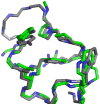Circular Permutation of the Trp-cage: Fold Rescue upon Addition of a Hydrophobic Staple
- PMID: 24376912
- PMCID: PMC3870897
- DOI: 10.1039/C3RA43674H
Circular Permutation of the Trp-cage: Fold Rescue upon Addition of a Hydrophobic Staple
Abstract
The Trp-cage, at 20 residues in length, is generally acknowledged as the smallest fully protein-like folding motif. Linking the termini by a two-residue unit and excising one residue affords circularly permuted sequences that adopt the same structure. This represents the first successful circular permutation of any fold of less than 50-residue length. As was observed for the original topology, a hydrophobic staple near the chain termini is required for enhanced fold stability.
Figures




Similar articles
-
Optimizing the fold stability of the circularly permuted Trp-cage motif.Biopolymers. 2019 Dec;110(12):e23327. doi: 10.1002/bip.23327. Epub 2019 Sep 3. Biopolymers. 2019. PMID: 31479150
-
Circular permutation of granulocyte colony-stimulating factor.Biochemistry. 1999 Apr 6;38(14):4553-63. doi: 10.1021/bi982224o. Biochemistry. 1999. PMID: 10194377
-
Role of tryptophan side chain dynamics on the Trp-cage mini-protein folding studied by molecular dynamics simulations.PLoS One. 2014 Feb 7;9(2):e88383. doi: 10.1371/journal.pone.0088383. eCollection 2014. PLoS One. 2014. PMID: 24563686 Free PMC article.
-
Circularly permuted DNA, RNA and proteins--a review.Gene. 1993 Mar 30;125(2):111-4. doi: 10.1016/0378-1119(93)90317-v. Gene. 1993. PMID: 7681803 Review.
-
Circularly permuted tRNA genes: their expression and implications for their physiological relevance and development.Front Genet. 2014 Apr 1;5:63. doi: 10.3389/fgene.2014.00063. eCollection 2014. Front Genet. 2014. PMID: 24744771 Free PMC article. Review.
Cited by
-
Aryl-aryl interactions in designed peptide folds: Spectroscopic characteristics and optimal placement for structure stabilization.Biopolymers. 2016 Jun;105(6):337-356. doi: 10.1002/bip.22821. Biopolymers. 2016. PMID: 26850220 Free PMC article.
-
Tightening up the structure, lighting up the pathway: Application of molecular constraints and light to manipulate protein folding, self-assembly and function.Sci China Chem. 2014 Dec;57(12):1615-1624. doi: 10.1007/s11426-014-5225-5. Sci China Chem. 2014. PMID: 25722715 Free PMC article.
-
Circular permutation of a WW domain: folding still occurs after excising the turn of the folding-nucleating hairpin.J Am Chem Soc. 2014 Jan 15;136(2):741-9. doi: 10.1021/ja410824x. Epub 2014 Jan 3. J Am Chem Soc. 2014. PMID: 24350581 Free PMC article.
-
Design and Engineering of Miniproteins.ACS Bio Med Chem Au. 2022 Apr 28;2(4):316-327. doi: 10.1021/acsbiomedchemau.2c00008. eCollection 2022 Aug 17. ACS Bio Med Chem Au. 2022. PMID: 37102166 Free PMC article. Review.
-
Tuning the Attempt Frequency of Protein Folding Dynamics via Transition-State Rigidification: Application to Trp-Cage.J Phys Chem Lett. 2015 Feb 5;6(3):521-6. doi: 10.1021/jz502654q. J Phys Chem Lett. 2015. PMID: 26120378 Free PMC article.
References
-
- Lo WC, Lee CC, Lee CY, Lyu PC. Nucleic Acids Res. 2009;37:D328. CPDB (Circular Permutation Data Base) is found under http://sarst.life.nthu.edu.tw/cpdb/ - PMC - PubMed
-
- Kier B, Byrne A, Scian M, Anderson J, Andersen NH. Folding landscape exploration by circular permutation and capping β structures. In: Kokotos G, Constantinou V, Matsoukas J, editors. Peptides 2012, Proceeding of the 32ndEPS. 2012. pp. 70–71.
-
- Neidigh JW, Fesinmeyer RM, Andersen NH. Nat Struct Biol. 2002;9:425. - PubMed
Grants and funding
LinkOut - more resources
Full Text Sources
Other Literature Sources
Research Materials
